BMW 5 Series: Driving
 BMW 5 Series: Driving
BMW 5 Series: Driving
- Vehicle equipment
- Start/Stop button
- Starting the engine
- Engine stop
- Automatic Engine Start/Stop Function
- Parking brake
- Turn signal, high beams, headlamp flasher
- Washer/wiper system
- Washer fluid
- Manual transmission
- Automatic transmission with Steptronic
Vehicle equipment
All standard, country-specific and optional equipment that is offered in the model series is described in this chapter. Therefore, equipment is also described that is not available in a vehicle, e. g., because of the selected optional equipment or country variant. This also applies for safety-related functions and systems.
Start/Stop button
The concept
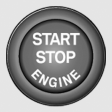 Pressing the Start/Stop button
switches the ignition on or off and
starts the engine.
Pressing the Start/Stop button
switches the ignition on or off and
starts the engine.
Automatic transmission: the engine starts if the brake is depressed when the Start/Stop button is pressed.
Manual transmission: the engine starts if the clutch is depressed when the Start/Stop button is pressed.
Ignition on
Automatic transmission: press the Start/Stop button, and do not press on the brake pedal at the same time.
Manual-shift transmission: press the Start/Stop button, and do not press on the clutch pedal at the same time.
All vehicle systems are ready for operation.
Most of the indicator and warning lamps in the instrument cluster light up for varying lengths of time.
To save battery power when the engine is off, switch off the ignition and any unnecessary electronic systems/power consumers.
The ignition switches off automatically:
▷ When the vehicle is locked, if the low beams
are switched on.
▷ Shortly before the battery is discharged
completely, so that the engine can still be
started.
▷ If the engine is switched off and the ignition
is switched on, the system automatically
switches to the radio ready state when the
door is opened if the lights are switched off
or the daytime running lights are switched
on.
Ignition off
Automatic transmission: press the Start/Stop button again, and do not press on the brake pedal at the same time.
Manual-shift transmission: press the Start/Stop button again, and do not press on the clutch pedal at the same time.
All indicator lamps in the instrument cluster go out.
To save battery power when the engine is off, switch off the ignition and any unnecessary electronic systems/power consumers.
 Transmission position P with the ignition
off
Transmission position P with the ignition
off
When the ignition is switched off, position P is
engaged automatically. When in an automatic
car wash, for example, ensure that the ignition is
not switched off accidentally.◀
Ignition automatically cuts off while the vehicle is stationary and the engine is stopped:
▷ During locking, also with the low beams activated.
▷ Shortly before the battery is discharged
completely, so that the engine can still be
started. This function is only available when
the low beams are switched off.
▷ When opening and closing the driver door, if
the driver's seat belt is unbuckled and the
low beams are switched off.
▷ While the driver's seat belt is unbuckled, if
the driver's door is open and the low beams
are switched off.
When the ignition is switched off, by opening or closing the driver's door or unbuckling the driver's seat belt, the radio ready state remains active.
Radio ready state
Activate radio ready state:
▷ When the ignition is switched off: press ON/
OFF button on the radio.
▷ When the engine is running: press START/
STOP button.
Some electronic systems/power consumers remain ready for operation.
Radio ready state switches off automatically:
▷ After approx. 8 minutes.
▷ When the vehicle is locked using the central
locking system.
▷ Shortly before the battery is discharged
completely, so that the engine can still be
started.
Starting the engine
General information
 Enclosed areas
Enclosed areas
Do not let the engine run in enclosed
areas; otherwise, breathing of exhaust fumes
may lead to loss of consciousness and death.
The exhaust gases contain carbon monoxide, an odorless and colorless but highly toxic gas.◀
 Unattended vehicle
Unattended vehicle
Do not leave the car unattended with the
engine running; otherwise, it presents a potential
source of danger.Before leaving the car with the engine running,
set the parking brake and place the transmission
in position P or neutral to prevent the car from
moving.
 Frequent starting in quick succession
Frequent starting in quick succession
Avoid repeated futile attempts at starting
the car and avoid starting the car frequently in
quick succession. Otherwise, the fuel is not
burned or is inadequately burned, and there is
the danger of overheating and damaging the
catalytic converter.◀
Do not wait for the engine to warm up while the vehicle remains stationary. Start driving at moderate engine speeds.
Manual transmission
Starting the engine
1. Depress the brake pedal.
2. Press on the clutch and shift to neutral.
3. Press the Start/Stop button.
The ignition is activated automatically for a certain time and is stopped as soon as the engine starts.
Automatic-Transmission
Starting the engine
1. Depress the brake pedal.
2. Press the Start/Stop button.
The ignition is activated automatically for a certain time and is stopped as soon as the engine starts.
Engine stop
General information
 Take the remote control with you
Take the remote control with you
Take the remote control with you when
leaving the vehicle so that children, for example,
cannot release the parking brake.◀
 Set the parking brake and further secure
the vehicle as required
Set the parking brake and further secure
the vehicle as required
Set the parking brake firmly when parking; otherwise,
the vehicle could roll. On steep upward
and downward inclines, further secure the vehicle,
for example, by turning the steering wheel in
the direction of the curb. ◀
Before driving into a car wash
In order for the vehicle to be able to roll into a car wash, heed the information regarding Washing in automatic car washes
Manual transmission
Switching off the engine
1. With the vehicle at a standstill, press the Start/Stop button.
2. Shift into first gear or reverse.
3. Set the parking brake.
Automatic-Transmission
Switching off the engine
1. Engage transmission position P with the vehicle
stopped.
2. Press the Start/Stop button.
The engine is switched off.
The radio ready state is switched on.
3. Set the parking brake.
Automatic Engine Start/Stop Function
The concept
The automatic engine start-stop function helps save fuel. The system switches off the engine during a stop, e. g., in a traffic congestion or at traffic lights. The ignition remains switched on.
The engine starts again automatically for driving off.
Automatic mode
The automatic engine start/stop function is operational after each engine start.
The function is activated above a certain speed.
▷ Manual transmission: above 3 mph, approx.
5 km/h.
▷ Automatic transmission: from 5 mph, approx.
9 km/h.
Engine stop
The engine is switched off automatically during a stop under the following conditions:
Manual transmission:
▷ Neutral is engaged and the clutch pedal is
not pressed.
▷ The driver's safety belt is buckled or the
driver's door is closed.
Automatic transmission:
▷ The selector lever is in transmission position
D.
▷ The brake pedal remains pressed while the
vehicle is stationary or the vehicle is held by
Automatic Hold.
▷ The driver's safety belt is buckled or the
driver's door is closed.
The air volume of the air conditioner is reduced when the engine is switched off.
Display in the instrument cluster
 The display indicates that the Automatic
Engine Start/Stop Function
is ready for an automatic engine
start.
The display indicates that the Automatic
Engine Start/Stop Function
is ready for an automatic engine
start.
Note
The engine is not switched off automatically in the following situations:
▷ External temperature below approx. +37 ℉/
+3 ℃.
▷ External temperature above approx. +95 ℉/
+35 ℃ and the automatic climate control is
operating.
▷ The passenger compartment has not yet
been heated or cooled to the required level.
▷ The engine is not yet at operating temperature.
▷ The wheels are at a sharp angle or the steering
wheel is being turned.
▷ After driving in reverse.
▷ Fogging of the windows when the automatic
climate control is switched on.
▷ The vehicle battery charge is very low.
▷ The engine compartment lid is unlocked.
▷ HDC is activated.
▷ The parking assistant is activated.
▷ Stop-and-go traffic.
Starting the engine
The engine starts automatically under the following conditions:
▷ Manual transmission:
The clutch pedal is pressed.
▷ Automatic transmission:
By releasing the brake pedal.
When Automatic Hold is activated: press the
accelerator.
After the engine starts, accelerate as usual.
Safety mode
After the engine switches off automatically, it will not start again automatically if any one of the following conditions are met.
▷ The driver's safety belt is unbuckled and the
driver's door is open.
▷ The hood was unlocked.
The indicator lamps come on.
The engine can only be started via the Start/ Stop button.
Note
Even if driving away was not intended, the deactivated engine starts up automatically in the following situations:
▷ Excessive warming of the passenger compartment
when the cooling function is
switched on.
▷ The steering wheel is turned.
▷ Automatic transmission: the transmission
position is changed from D to N, R, or M/S.
▷ Automatic transmission: the transmission
position is changed from P to N, D, R, or M/
S.
▷ Automatic transmission: the accelerator and
the brake are pressed at the same time.
▷ The vehicle begins rolling.
▷ Fogging of the windows when the automatic
climate control is switched on.
▷ The vehicle battery charge is very low.
▷ Excessive cooling of the passenger compartment
when the heating is switched on.
▷ Low brake vacuum pressure; this can occur,
for example, if the brake pedal is depressed
a number of times in succession.
Preventing an automatic engine stop with automatic transmission
The concept
To make it possible to drive away very quickly, such as at an intersection, the automatic engine stop can be actively prevented.
Preventing an engine stop using the brake pedal
The engine stop can be actively prevented within one second after the vehicle comes to a standstill.
▷ Immediately after the vehicle comes to a
standstill, briefly press the brake pedal
forcefully.
▷ Then press the brake pedal with normal
braking force.
Activating/deactivating the system manually
Using the button
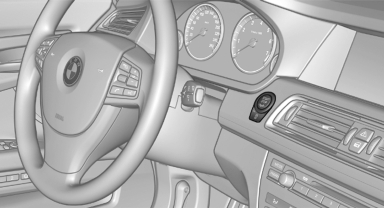
 Press the button.
Press the button.
▷ LED comes on: Auto Start Stop function is
deactivated.
The engine is started during an automatic
engine stop.
The engine can only be stopped or started
via the Start/Stop button.
▷ LED goes out: Auto Start Stop function is
activated.
Switching off the vehicle during an automatic engine stop
During an automatic engine stop, the vehicle can be switched off permanently, e.g., when leaving it.
1. Press the Start/Stop button. The ignition is switched off. The Automatic Engine Start/ Stop Function is deactivated.
Automatic transmission: the transmission position P is engaged automatically.
2. Set the parking brake.
Engine start as usual via Start-/Stop button.
Automatic deactivation
In certain situations, the Automatic Engine Start/ Stop Function is deactivated automatically for safety reasons, such as when the driver is detected to be absent
Malfunction
The automatic engine start/stop function no longer switches of the engine automatically. A Check Control message is displayed. It is possible to continue driving. Have the system checked.
Parking brake
The concept
The parking brake is primarily intended to prevent the vehicle from rolling while parked; it brakes the rear wheels.
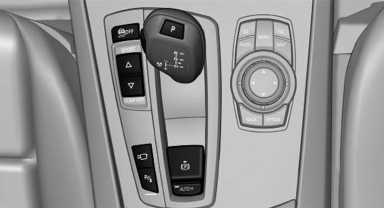
Setting
 Pull the switch.
Pull the switch.
The LED lights up.
 The indicator lamp lights up in
red. The
parking brake is set.
The indicator lamp lights up in
red. The
parking brake is set.
 Lower lamp: indicator lamp in
Canadian
models
Lower lamp: indicator lamp in
Canadian
models
 Set the parking brake and further secure
the vehicle as required
Set the parking brake and further secure
the vehicle as required
Set the parking brake firmly when parking; otherwise,
the vehicle could roll. On steep upward
and downward inclines, further secure the vehicle,
for example, by turning the steering wheel in
the direction of the curb. ◀
While driving
Use while driving serves as an emergency braking function:
Pull the switch and hold it. The vehicle brakes hard while the button is being pulled.
 The indicator lamp lights up in
red, a signal
sounds and the brake lamps light up.
The indicator lamp lights up in
red, a signal
sounds and the brake lamps light up.
 Lower lamp: indicator lamp in
Canadian
models
Lower lamp: indicator lamp in
Canadian
models
If the vehicle is braked to a speed of approx.
2 mph/3 km/h, the parking brake remains set.
Releasing
With the ignition switched on:
 Manual transmission: Press the
switch
while the brake or clutch is pressed.
Manual transmission: Press the
switch
while the brake or clutch is pressed.
Automatic transmission: Press the switch while the brake is pressed or transmission position P is engaged.
The LED and indicator lamp go out.
The parking brake is released.
Automatic Release in cars with automatic transmission
For automatic release, operate the accelerator pedal.
The LED and indicator lamp go out.
Subject to the following requirements, the parking brake is automatically released by operation of the accelerator pedal:
▷ Engine on.
▷ Drive position engaged.
▷ Driver buckled in and doors closed.
 Inadvertent operation of the accelerator
pedal
Inadvertent operation of the accelerator
pedal
Make sure that the accelerator pedal is not operated
unintentionally; otherwise, the vehicle is
set in motion and there is a risk of an accident.◀
Automatic Hold
The concept
This system assists the driver by automatically setting and releasing the brake, such as when moving in stop-and-go traffic.
The vehicle is automatically held in place when it is stationary.
On inclines, the system prevents the vehicle from rolling backward when driving away.
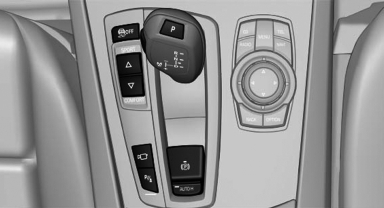
For your safety
Under the following conditions, Automatic Hold is automatically deactivated and the parking brake is set:
▷ The engine is switched off.
▷ A door is opened and driver's safety belt is
unbuckled while the vehicle is stationary.
▷ The moving vehicle is brought to a standstill
using the parking brake.
 The indicator lamp switches from
green
to red and the letters AUTO H go out.
The indicator lamp switches from
green
to red and the letters AUTO H go out.
 Lower lamp: indicator lamp in
Canadian
models
Lower lamp: indicator lamp in
Canadian
models
 Leaving the vehicle with the engine running
Leaving the vehicle with the engine running
Before leaving the vehicle with the engine running,
engage position P of the automatic transmission
and ensure that the parking brake is set.
Otherwise, the vehicle may begin to roll.◀
Activating
This function can be activated when the driver's door is closed and the safety belt is fastened, or while driving.
 Press the button.
Press the button.
The LED and the letters AUTO H light up.
 The indicator lamp lights up.
The indicator lamp lights up.
Automatic Hold is activated.
Deactivating
 Press the button again.
Press the button again.
The LED and the letters AUTO H go out.
Automatic Hold is deactivated.
If the vehicle is being held by Automatic Hold, press on the brake pedal to deactivate it.
When the parking brake, is set manually, Automatic Hold is deactivated automatically.
Driving
Automatic Hold is activated: the vehicle is automatically secured against rolling when it stops.
 The indicator lamp lights up in
green.
The indicator lamp lights up in
green.
Step on the accelerator pedal to drive off.
 The brake is released
automatically.
The brake is released
automatically.
The indicator lamp goes out.
Lower lamp: indicator lamp in Canadian models
 Before driving into a car wash
Before driving into a car wash
Deactivate Automatic Hold; otherwise, the
parking brake will be set when the vehicle is stationary
and the vehicle will no longer be able to
roll.◀
Parking
The parking brake is automatically set if the engine is switched off while the vehicle is being held by Automatic Hold.
 The indicator lamp changes from
green
to red.
The indicator lamp changes from
green
to red.
 The parking brake is not set if
the engine
is switched off while the vehicle is coasting
to a halt. Automatic Hold is deactivated.
The parking brake is not set if
the engine
is switched off while the vehicle is coasting
to a halt. Automatic Hold is deactivated.
Lower lamp: indicator lamp in Canadian models Automatic Hold remains activated during an engine stop brought about by the Automatic Engine Start/Stop Function.
 Take the remote control with you
Take the remote control with you
Take the remote control with you when
leaving the vehicle so that children, for example,
cannot release the parking brake.◀
Malfunction
In the event of a failure or malfunction of the parking brake, secure the vehicle against rolling using a wheel chock, for example, when leaving it.
Turn signal, high beams, headlamp flasher
Turn signal
Using turn signals
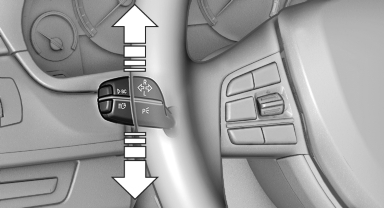
Using turn signals
Press the lever beyond the resistance point.
To switch off manually, press the lever to the resistance point.
Unusually rapid flashing of the indicator lamp indicates that a turn signal bulb has failed.
Triple turn signal activation
Press the lever to the resistance point.
The turn signal flashes three times.
The function can be activated or deactivated:
1. "Settings"
2. "Lighting"
3. "Triple turn signal"
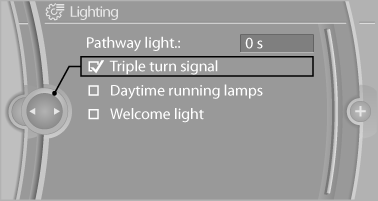
Signaling briefly
Press the lever to the resistance point and hold it there for as long as you want the turn signal to flash.
High beams, headlamp flasher
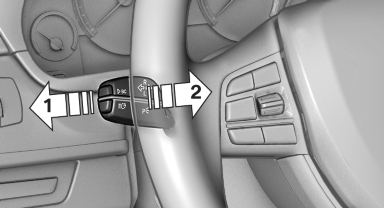
High beams, headlamp flasher
▷ High beams, arrow 1.
▷ Headlamp flasher, arrow 2.
Washer/wiper system
Switching the wipers on/off and brief wipe
 Do not switch on the wipers if frozen
Do not switch on the wipers if frozen
Do not switch on the wipers if they are frozen
onto the windshield; otherwise, the wiper
blades and the windshield wiper motor may be
damaged.◀
Switching on
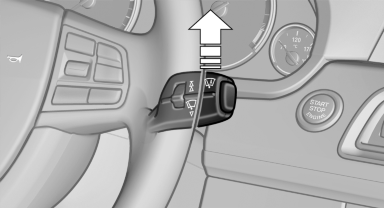
Press the wiper levers up.
The lever automatically returns to its initial position when released.
▷ Normal wiping speed: press up once.
The wipers switch to intermittent operation
when the vehicle is stationary.
▷ Fast wiping speed: press up twice or press
once beyond the resistance point.
The wipers switch to normal speed when the vehicle is stationary.
Switching off and brief wipe
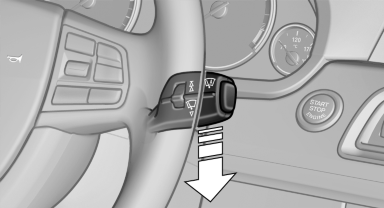
Switching off and brief wipe
Press the wiper levers down.
The lever automatically returns to its initial position when released.
▷ Brief wipe: press down once.
▷ To switch off normal wipe: press down once.
▷ To switch off fast wipe: press down twice.
Rain sensor
The concept
The time between wipes is controlled automatically and depends on the intensity of the rainfall.
The sensor is located on the windshield, directly in front of the interior rearview mirror.
Activating/deactivating the rain sensor
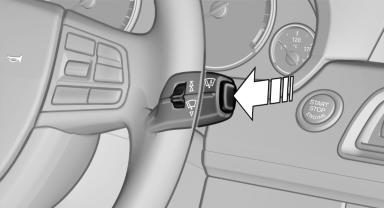
Activating/deactivating the rain sensor
Press the button on the wiper lever.
When activated, the wipers move over the windshield once.
The LED in the steering column stalk lights up.
 Deactivate the rain sensor in car washes<>
Deactivate the rain sensor when passing
through an automatic car wash; otherwise, damage
could be caused by undesired wiper activation.◀
Deactivate the rain sensor in car washes<>
Deactivate the rain sensor when passing
through an automatic car wash; otherwise, damage
could be caused by undesired wiper activation.◀
Rain sensor sensitivity
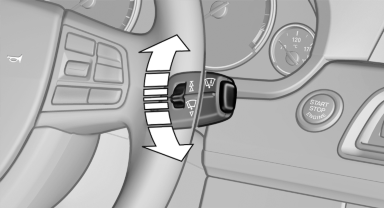
Rain sensor sensitivity
Turn the thumbwheel.
Clean the windshield, headlamps
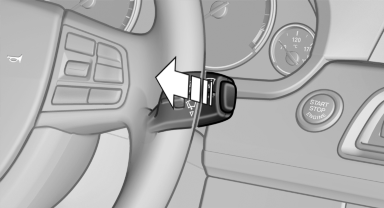
Clean the windshield, headlamps
Pull the lever.
The system sprays washer fluid on the windshield and activates the wipers briefly.
In addition, the headlamps are cleaned at regular intervals when the vehicle lights are switched on.
 Do not use the washer system at freezing
temperatures
Do not use the washer system at freezing
temperatures
Do not use the washers if there is any danger
that the fluid will freeze on the windshield; otherwise,
your vision could be obscured. For this
reason, use antifreeze.
Avoid using the washer when the reservoir is empty; otherwise, you could damage the pump.◀
Windshield washer nozzles
The washer jets are automatically heated whenever the ignition is switched on.
Fold-out position of the wipers
Required when changing the wiper blades or under frosty conditions, for example.
1. Switch off the ignition.
2. Under frosty conditions, ensure that the
wiper blades are not frozen onto the windshield.
3. Press the wiper lever up beyond the point of
resistance and hold it for approx. 3 seconds,
until the wiper remains in a nearly vertical
position.
After the wipers are folded back down, the wiper system must be reactivated.
 Fold the wipers back down
Fold the wipers back down
Before switching the ignition on, fold the
wipers back down to the windshield; otherwise,
the wipers may become damaged when they are
switched on.◀
1. Switch on the ignition.
2. Press the wiper levers down. The wipers
move to their resting position and are ready
for operation.
Washer fluid
General information
 Antifreeze for washer fluid
Antifreeze for washer fluid
Antifreeze is flammable. Therefore, keep
it away from sources of ignition.
Only keep it in the closed original container and inaccessible to children.
Follow the instructions on the container.◀
Washer fluid reservoir
Adding washer fluid
Only add washer fluid when the engine is
cool, and then close the cover completely to
avoid contact between the washer fluid and hot
engine parts.
Otherwise, there is the danger of fire and a risk to personal safety if the fluid is spilled.◀
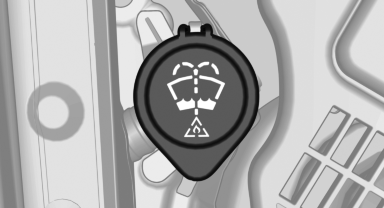
All washer nozzles are supplied from one reservoir.
Fill with water and – if required – with a washer antifreeze, according to the manufacturer's recommendations.
Mix the washer fluid before adding to maintain the correct mixing ratio.
Manual transmission
Shifting
 Shifting into 5th or 6th gear
Shifting into 5th or 6th gear
When shifting into 5th or 6th gear, push
the gearshift lever to the right; otherwise inadvertent
shifting into the 3rd or 4th gear could
lead to engine damage.◀
Reverse gear
Select only when the vehicle is stationary. When the gearshift lever is pressed to the left, a slight resistance needs to be overcome.
Automatic transmission with Steptronic
Transmission positions
D Drive, automatic position
Position for normal vehicle operation. All forward gears are available.
R is Reverse
Select only when the vehicle is stationary.
N is Neutral
Use in automatic car washes, for example. The vehicle can roll.
When the ignition is switched off, position P is engaged automatically.
P Park
Select only when the vehicle is stationary. The drive wheels are blocked.
P is engaged automatically:
▷ After the engine is switched off, if the car is
in radio ready state, or if the
ignition is switched off, and
if position R or D is engaged.
▷ With the ignition is off, if position N is engaged.
▷ If the safety belt is unbuckled, the driver's
door is opened, and the brake pedal is not
pressed while the vehicle is stationary and
transmission position R or D is engaged.
Before exiting the vehicle, make sure that position P of the automatic transmission is engaged.
Otherwise, the vehicle may begin to roll.
Kickdown
Kickdown is used to achieve maximum driving performance. Press on the gas pedal beyond the resistance point at the full throttle position.
Engaging the transmission position
▷ Transmission position P can only be disengaged
if the engine is running and the brake
pedal is pressed.
▷ With the vehicle stationary, press on the
brake pedal before shifting out of P or N;
otherwise, the shift command will not be
executed: shift lock.
 Depress the brake until you start driving
Depress the brake until you start driving
To prevent the vehicle from creeping after
you select a driving position, maintain pressure
on the brake pedal until you are ready
to start.◀
Engaging D, R and N
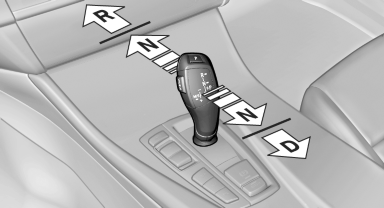
Briefly push the selector lever in the desired direction, beyond a resistance point if necessary.
After releasing the selector lever, it returns to its center position.
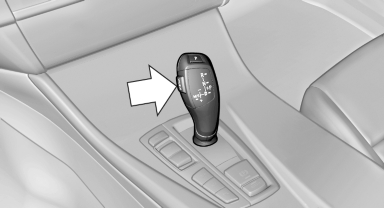
Press unlock button, in order to:
▷ Engage R.
▷ Shift out of P.
Engaging P
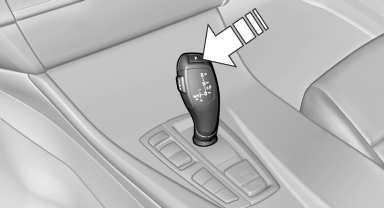
Press button P.
Sport program DS and manual mode M/ S
Push the selector lever to the left out of transmission position D.
DS is displayed in the instrument cluster.
The sport program of the transmission is activated.
Activating the M/S manual mode
Push the selector lever to the left out of transmission position D.
Push the selector lever forward or backward.
Manual mode becomes active and the gear is changed.
The engaged gear is displayed in the instrument cluster, e.g., M1.
▷ To shift down: press the selector lever forward.
▷ To shift up: pull the selector lever rearwards.
The vehicle only shifts up or down at appropriate engine and road speeds, e.g., it does not shift down if the engine speed is too high.
The selected gear is briefly displayed in the instrument cluster, followed by the current gear.
Ending the sport program/manual mode
Push the selector lever to the right.
D is displayed in the instrument cluster.
Shift paddles for Sport automatic transmission
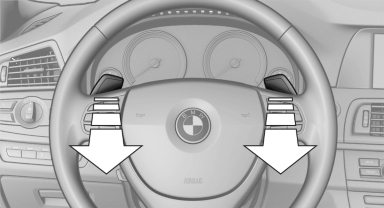
Shift paddles for Sport automatic
transmission
The shift paddles on the steering wheel allow you to shift gears quickly while keeping both hands on the steering wheel.
If the shift paddles on the steering wheel are used to shift gears in automatic mode, the transmission temporarily switches to manual mode.
If the shift paddles are not used and the vehicle is not accelerated for a certain time, the system switches back into automatic mode if the selector lever is in transmission position D.
▷ Shift up: pull right shift paddle.
▷ Shift down: pull left shift paddle.
The vehicle only shifts up or down at appropriate engine and road speeds, e.g., it does not shift down if the engine speed is too high.
The selected gear is briefly displayed in the instrument cluster, followed by the current gear.
Displays in the instrument cluster
 The transmission
position is displayed,
e.g.: P.
The transmission
position is displayed,
e.g.: P.


